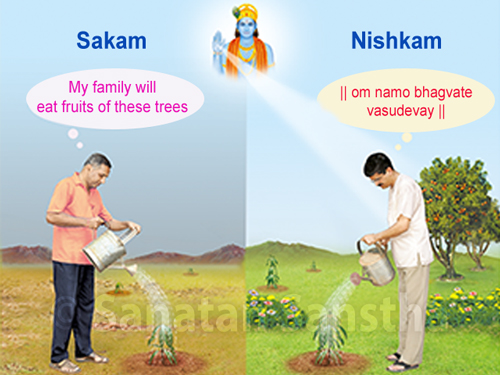Making efforts to merge with the God Principle is called sadhana. When sadhana is done with expectations from God it is called sakam sadhana and when a seeker performs sadhana without expectations it is called as nishkam sadhana.

Seekers should constantly introspect whether they are moving towards nishkam sadhana, and to accomplish this, they should change their thoughts and actions appropriately as per the expectations of the Guru.
| Sakam sadhana | Nishkam sadhana | |
|---|---|---|
| 1. Definition | Karma performed with some expectation | Karma performed by the intellect without any expectations |
| 2. Spiritual level of the individual who can perform this | 25 to 30 percent | Above 45% |
| 3. Inclination towards own wish, towards others’ wish and God’s wish | Towards own wish | Towards othersshel of th Godards ot |
| 4. Attitude | Extrovert | More towards becoming an introvert |
| 5. Emotions / bhav (Spiritual emotion) | Emotions | Bhav |
| 6. Effect | The individual gets entangled in happiness and unhappiness | The individual remains in the state of sakshibhav and experiences Anand (Bliss) |
| 7. Result | God’s grace depends on karma and bhav | Continuous flow of God’s grace |
A. Sakam sadhana (With expectations from God) is known as ‘worship’ and nishkam sadhana is known as ‘Divine grace’.
B. The process of God fulfilling desires of a devotee, and energy of the devotee getting depleted to accomplish it : Nurturing a feeling that God relieves devotees of their suffering means expecting that God should do so. To fulfill the expectations of a devotee, God has to manifest Himself; He has to expend His energy. Due to these types of thoughts in Saints (to alleviate the suffering of devotees), God is forced to interfere in the destiny of the devotee. However, in this process, the sadhana of the devotee gets depleted.
C. Nishkam sadhana is superior to sakam sadhana : Asking God for something for yourself amounts to sakam sadhana. However, remaining engrossed in samashti sadhana without asking God for anything is the highest type of nishkam sadhana, thus making it most effective.
-
A mother is more attentive towards the son who does not ask for anything unlike the one who is constantly asking for something or the other, because she knows that the former will not ask for something on his own. Similarly, God has to come to the rescue of His devotee who does not ask Him for anything.
-
Due to nishkam sadhana, the nirguntattva (Non-materialised Principle) of God remains active for the sake of devotees to a greater extent. In sakam sadhana, the saguntattva (Materialised Principle) of God remains more active. The nirguntattva is always more functional than the saguntattva.
-
When you ask God for something, the God Principle acts only as per the prayer made. However, when no prayer is made, the God Principle gives much more and on a greater scale than when a prayer is made. Thus, the benefit to the devotee as well as to the society is much more.
-
Doing anything with expectations leads to narrow-mindedness; whereas, doing something without expectations leads to expansiveness.
From the spiritual perspective, since the proportion of samashti bhav is very high in Saints and since they perform samashti mission, even though they do not ask God for anything, God is compelled to fulfill their mission due to their bhav. An average individual performing a samashti mission does not possess such a high level of samashti bhav. If such people ask God for help not for their own sake but for the samashti mission, God helps at once. In other words, asking God from the perspective of society’s benefit; for example, a prayer such as, ‘Please bestow me with the energy and intellect to further the mission of spreading Dharma (Righteousness),’ is in a way nishkam sadhana. – His Holiness Dr. Jayant Athavale (Sanatan’s source of inspiration)
Reference : Sanatan Sanstha’s Holy text ‘Sadhana (Spiritual practice)’


